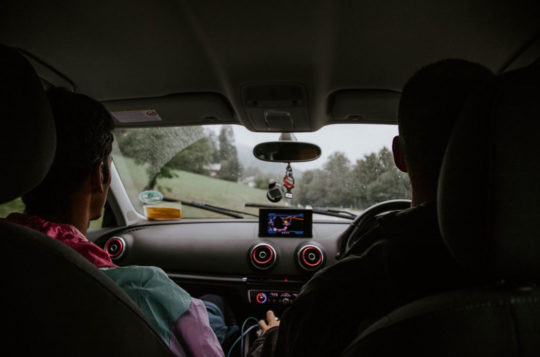74 actions to improve road safety, but here’s 10 of them for now

In the late summer, the government released a major action plan to help reduce the number of people killed and injured on UK roads. It was an extensive report - 69 pages long in fact! It included 74 changes, developments, new proposal ideas, research projects...
And since we know our ingenie family are busy people, we've finally got to the end of the heavy reading so you don't have to, and pulled out 10 points we think you should know about.
"The UK has some of the safest roads in the world, but we are not complacent and continue to look at how we can make them safer. This action plan is a key milestone in our road safety work and sets out the important steps we are taking to reduce the number of people killed or seriously injured on our roads."Chris Grayling
Transport Secretary
-
Smartphone zombies
We're all a little bit guilty of this. Walking, heads down, engrossed in our phones, messaging or desperately trying to get to the next level of Bubble Witch Saga. But as adults, we have enough road safety awareness to realise stepping out into a road mid game is an accident waiting to happen. Childen however, don't have this risk assessment part of their brain fully developed yet.
Walking to school is a huge milestone for young children - with a load of benefits from growing independence, exercise and flexibility for parents. But as with any big jump in freedom, comes the worry about safety.
The Department's THINK! team found that the main contributory factors for child pedestrian casualties, aged between 7-16, was failure to look (e.g. mobile phones and listening to music) and dangerous action in the carriageway (e.g. playing).

To help combat this the team added 'Stop, Look, Listen, Think' and 'Dangerous Habits (distraction)' to their educational resources and these have been promoted over the last year to teachers and local road safety officers. The government will look to review the success of these, however there's already been a 93% increase in teachers claiming safer road safety behaviour among children and young people (June 2017 to June 2018).
Help for instructors to conduct mock tests
Being able to get as close to a real test environment is fundamental preparation for any exam. To help learners feel more ready for the big test day, the DVSA will be updating its guidance for Approved Driving Instructors (ADIs) on how to conduct mock tests.
There will also be an increase in the number of education and training interventions available for ADIs with the view to improving awareness and participation.
Assessing the driving test
The roads we use are constantly changing, along with the cars and the technologies we use to drive on them. To make sure the current driving test reflects the skills and knowledge needed for today's driver, the DVSA will review its national standards and evolve with new tech, with the aim of helping to produce safe and responsible drivers.
Another important evolution of the practical test is to make sure that the test routes allow assessment of a learner's ability to drive safely and responsibly in a range of road and traffic conditions. This is not only a crucial way to assess a driver, but also exposes them to what driving post-test will be like.
Developing the hazard perception test
Many people have the belief that the theory test is secondary to the practical in terms of value. This simply isn't the case. One of the main functions of the theory test is to assess knowledge and understanding of some of the higher risk situations that learners may never encounter when they're sat behing the wheel of their learner car.
The DVSA are currently working with the RAC foundation and Nottingham Trent University, to broaden the scope of the clips shown in the hazard perception element of the test as well as the ways the test can work with a range of media and platforms.
Newer clips will include interaction with vulnerable road users, particularly cyclists, pedestrians and horse riders - again, preparing learners for a wider range of road conditions.

Reviewing learners on the motorway legislation
Back in June 2018, learner drivers got given the green flag to take lessons on the motorway with their instructor. The huge policy change was intended to boost motorway driving skills and confidence before having to tackle these roads for the first time unsupervised once they'd passed their test.
Has it worked? Are young drivers more comfortable on the motorway as a result? The government will evaluate the effectiveness of the change to driving lesson structure by rolling out a programme of online surveys to recent test takers. Drivers will be asked about their learning experience, with a series of follow up surveys to look to see if there's been any improvement in their independent driving.
Effectiveness of alcolocks
Alcohol ignition interlocks (clever devices that stop the car from starting if the driver's breath is over the alcohol limit), have proven to reduce drink-driving reoffending internationally according to recent studies.
The government will investigate the feasibility of using these devices as part of drink-drive offender rehabilitation programme in the UK. They will also explore how this can be used in combination with existing intervention schemes as well as looking into the practicalities behind making sure the technology is both accessible and reliable to roll out on a large scale.
Improving digital enforcement
In a plan to help protect the most vulnerable road users, especially when up against aggressive driving behaviour on our roads, initiatives such as Operation Snap or the National Dash Cam Portal (a platform that allows you to submit witness footage) were rolled out across Wales in 2017.
Camera footage increases the chances of identifying careless and dangerous drivers and their vehicles, and with supporting evidence, allows police to deal with those people much quicker.
The government will be looking at the success of these programmes and ways to improve the current digital enforcement in place to help empower witnesses.

Seat belt penalty points
The vast majority of drivers on our roads drive safely and within the law, but unfortunately there are some who don't. There is constant potential for good behaviour to turn, especially as constraints become familiar and distractions within the car increase.
Generally, (and thankfully) seat belt usage is high, but for the past few years the proportion of fatalities caused by not wearing a seat belt (where the seat belt use was known and recorded by the Police) has been over 20%. In 2017 the proportion rose to 27%, so something is moving these figures in the wrong direction.
Not wearing a seatbelt needs to be taken extremely seriously which is why the government are now considering the practicality of imposing penalty points on the driving licence if drivers or passengers flout the law on this. They are currently looking into which kind of drivers and passengers are failing to belt up, what prompts their risky behaviour and what interventions might best be implemented to reduce these fatalities.
Analysis of phone use at the wheel
Alongside the failure to wear a seat belt, the use of a hand-held phone is another major source of road death and injury, being a contributory factor to fatal collisions in 2017. In March 2017 the penalties for using a mobile at the wheel were doubled to a £200 fixed penalty and 6 penalty points. This meant new drivers would face immediate disqualification if caught by Police, but even with this extra risk of loss of licence, this behaviour is still seen as acceptable by some drivers.
The government are therefore carrying out analysis of existing data to gain a deeper understanding of the why, how and in what situations mobile phones are being used while driving. The results will be published by the end of this year and an action plan will then be made based on the evidence, to help stop this.
Evaluation of the THINK! campaigns on young male drivers
Young people tend to get the most stick for being unsafe drivers, and while it's unfair to tarnish all with the same brush, road casualty statistics show that young men aged 17-24 are the highest risk group of all car drivers.
The Department's current educational focus is for friends to look out for each other to help reduce risky behaviour behind the wheel. Peer influence is central to a young person's decision making, with fear of being judged or excluded often creating a reluctance to speak out about feeling unsafe.

The highly successful THINK! 2018-19 ‘Mates Matter’ drink drive campaign, saw the most significant shift in attitudes in the unacceptability of drink driving among young men in over a decade. It used the power of friendships to turn peers from a negative facilitator into a positive influencer.
Further planned activity will continue to target young male drivers to raise awareness of specific behaviours and reinforce vital road safety messages. There will be a continuous communications approach over the next 2 years that will highlight 4 major road safety hazards:
- Drink-driving
- The use of hand-held mobile phones while driving
- The danger associated with passenger distraction
- Speeding
Read the full article from the Department for Transport here.
Think you could do with brushing up on your road safety rules and regulations? Head to ingenie's Young Driver's Guide to help you stay on the right side of the law.

By Katey Gregory
Katey Joined ingenie in 2014 and is in charge of all things social and content. She passed her driving test in 2015 and her first car is a Toyota Yaris T3 named Tyrone.
To help your friend earn their Amazon voucher, you’ll need to get your quote now or come back using the link they sent you.






